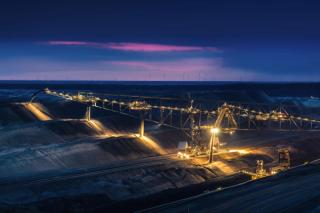
Cultural heritage: Indigenous and cultural heritage values driving sustainable development
by Flavia Kiperman
View post

In recent years, we have seen the growing adoption of GIS across many sectors. This is not limited to the ‘big tech’ companies. Smaller private and public organisations are also benefitting from the technology. Any data which can be assigned to a geographical location can be found in a GIS. This speeds up locating data and can improve efficiencies in analytics and decision making.
Developing a design to extract minerals safely is an inherent requirement for a Quarry Operator [1]. The development of a design will have been undertaken utilising CAD or ‘Computer Aided Design’ software packages. This will have used spatial data such as land surveys, permit boundaries and geological models. Despite this data being georeferenced, all too often, the design is delivered as a static plan.
If the design were delivered in a GIS platform, the quarry’s operational team could zoom, pan and analyse their designs. Could this allow a quarry’s leadership to enhance their efficiency and decision making? Furthermore, what additional data could be made available in the same platform? To answer these questions, let’s look at what GIS is, how it is being used by other industries and where there are effective examples already in quarrying.
GIS stands for a ‘Geographic Information System’, although it is sometimes referred to as an LIS or ‘Land Information System’. This is a software platform which marries a map to a database [2]. Information can be assigned to any position on, beneath or above the Earth’s surface. In practice, the user will click on or search for a location. The software then returns any data relating to the site form the database. This could be vector data overlaid on the map, a pop-up showing information pertaining to the position, or a link to view files associated with the locale.
Most of us are regularly using GIS, even if we don’t realise. Picture being invited to a meeting with a supplier. The invitation lists a time and an address. You type the address into a website such as Google Maps and enter the desired arrival time. The website tells you when to set off so that you will catch your train on time. It lists which line and train time to take. From the arrival station, it shows you the route to walk to the meeting venue. The website may even tell you to take a diversion to avoid a congested area. En-route to the venue, you search for a coffee shop where you can rest and prepare for the meeting. The website helps you to choose a café based upon whether it is along your route, its opening times, menu and customer feedback ratings. Finally, you arrive at the meeting on time, rested and prepared.
This website is much more than a map. All the additional metadata (the train times, the dynamic walking route, the café’s menu, etc.) elevates the map to a GIS.
GIS is utilised by organisations in a wide range of sectors, including but not limited to environmental science, health, aviation, education, real estate, public utilities, insurance, and mining.
Let’s use the example of a housing association. Such an organisation will surely have an interest in a series of land holdings. A GIS can be used as both the repository for, and the peripheral to view varied real estate related information. This could be represented as a map within the software displaying such information as property boundaries, planning permission limits or utility locations. Alternatively, it could provide links to key documentation such as land deeds, environmental licenses or permits. Havebury Housing Partnership has had a GIS developed for this purpose. Presented as a web-browser-based system, it allows their team to share data in an intuitive and easy to use viewer [3].
Such an approach can also be adopted by a quarry operator. Many such organisations often have wide ranging real-estate portfolios with various permissions and permits. The advantages demonstrated by housing associations can, and are, benefiting quarrying companies.
As well as mapping, GIS offers analytical insights. ESRI, the maker of the ArcGIS platform, celebrates client best-practice at their annual conference. The ‘Customer Success Awards’ showcase a range of applications for GIS [4]. As recognised in the 2021 awards, NHS South, Central and West (NHS SCW) utilised GIS during the COVID-19 vaccine rollout. “Critically, our team helped in the planning and modelling of the optimal location of vaccination site with the number of people in the catchment area, in the target age range, for each separate phase of the roll-out” [5].
Quarry operators can also benefit from such analytical insights. GIS platforms incorporate measuring tools in both 2D and 3D. For example, a sand and gravel provider could utilise such a platform to search for available capacity within a 30-mile radius of their customer’s delivery address, filtered to show sites where the product meets the sizing specification of the client’s order.
As any operator will know, the safe and economic management of a quarry relies on much more than following maps and designs. A key enabler to the efficient operation of a quarry is the ability to mine predictively. If the quarry manager knows in advance where the mineral quality is high and where it is poor, blending and waste management can be planned.
Take the example of quarrying limestone for cement manufacture. Limestone is the primary ingredient in cement. Although it varies between the many specifications of cement, it can make up as much as 90% of the raw mix [6]. The quarry’s customer, a cement plant, will set raw material quality targets to adhere to strict product standards. For example, lime saturation factor (LSF = 100*(CaO/(2.8*SiO2 + 1.2*Al2O3 + 0.65*Fe2O3)) would ideally be both high, and have low variability over time [7].
Environmental emissions breaches could lead to costly fines and reputational damage. For example, the Sulphur content of limestone fed to the kiln is directly related to SO2 emissions. In the UK and EU, SO2 is limited to 400 mg/Nm [8].
As the geology of a mineral deposit is inherently variable, often influenced by millions of years of earth movements (tectonics), heat, pressure, water, and ancient biological and environmental processes, mineral quality always varies across a quarry. Underperforming against the key performance indicators listed above can be avoided by blending lower quality limestone with higher quality limestone. This is done most efficiently by knowing the quality of the mineral in the ground before extraction.
The quarry operator will likely have been required to assess the quantity and quality of their Mineral Reserves and Resources in accordance with such reporting standards as PERC [9], or S-K 1300 [10]. To declare a saleable Mineral Reserve, the deposit will have been modelled in 3D utilising geological evidence and sampling. In the case of a chemical stone quarry, the mineral chemistry will have been modelled in the form of a detailed ‘block model’. This provides confidence that it will be a saleable raw material.
If a deposit has previously been modelled for reporting purposes, there are clear advantages to making this model available to the quarry’s leadership team. Such geological models do, however, require specialist software knowledge.
The case study of Havebury Housing Partnership, an easy-to-use web viewer was developed to simplify the locating and presentation of complex data [11]. A similar approach can be taken to make the block model easily accessible to the quarry’s leadership, without the need to learn how to use complicated software.
Tarmac, a CRH company, have been recognised for their use of GIS with an ESRI customer success award in 2024 [12].
The GIS in question has been developed in the ArcGIS Online platform and is accessible within a web browser. A series of layers are presented, which can be toggled on and off by the user. The block model has been presented as a mineral quality map for each bench in the quarry. The quarry manager can point-and-click to select where they would like to drill and blast. A pop-up displays the estimated chemistry at the location. Parameters such as LSF and Sulphur content are displayed, allowing the user to locate an area with the desired chemistry [13].
Additional layers are also available, such as the locations of production drillholes where chemical analysis has been carried out. This allows the user to reconcile the predicted block model chemistry with production chemistry.
Furthermore, a base layer consists of the drone (UAV) survey imagery to allow the user to efficiently navigate the site in 2D or 3D.
Finally, vector data has been provided. The quarry design can be displayed directly on the map, with essential design parameters such as the quarry face heights displayed on a point-and-click basis.
There are various options available for an organisation considering utilising GIS. A simple and cost-free option is to utilise Google Earth by creating polygons with pop-ups linking them to files [14]. A more sophisticated open-source system is available in the form of QGIS [15], which offers a growing range of analytical tools. The more bespoke web-viewer interfaces discussed above were produced using ESRI’s ArcGIS Online app builder [16]. This is a commercial option which an organisation can purchase for themselves, or commission a consultant to develop on their behalf.
In each case, it is essential to begin by asking what questions the user is seeking to answer and whether the required data exists. The GIS can only act as a repository for, and peripheral to a dataset. This means that the geological models, quarry design and any other relevant data should be mature.
To talk to our experts about your own GIS application, please get in touch.
Contact us--------------------------------------
References
[1] https://www.hse.gov.uk/pubns/books/l118.htm
[2] https://www.ordnancesurvey.co.uk/business-government/tools-support/gis/what-is-gis
[3] https://www.cadcorp.com/havebury-housing-introduces-gis-to-meet-corporate-strategy-objectives/
[4] https://www.esriuk.com/en-gb/about/events/customer-success-awards/overview
[5] https://scwcsu.nhs.uk/news-and-views/news/gis-excellence-rewarded-at-esriuk-customer-success-awards
[7] https://www.cemnet.com/Articles/story/164738/analysing-raw-mix-control.html
[8] https://eur-lex.europa.eu/legal-content/EN/TXT/PDF/?uri=CELEX:32001L0080&from=EN
[10] https://www.sec.gov/corpfin/secg-modernization-property-disclosures-mining-registrants
[11] https://www.cadcorp.com/havebury-housing-introduces-gis-to-meet-corporate-strategy-objectives/
[12] https://www.youtube.com/watch?v=gRXQrT62yvA
[13] Lawrence, S.P. 2018.Is it Time for Industrial Rocks and Minerals Geologists to Better Exploit Block Modelling? Pp. 63-69 in Anderson, P.E., Hunger, E., Brown, T.J. and Wardrop, D. and Horsley, N. (Eds.) Proceedings of the 20th Extractive Industry Geology Conference 2018 and technical meeting 2019, EIG Conferences Ltd, 126pp.
[14]https://www.google.com/earth/outreach/learn/annotating-google-earth/

by Flavia Kiperman

by Jasper Schrijvers , Matthew Hoare

by Clodagh Connolly, Nicola Inge, Andres Schottlaender